

From moisturizers to masks, these are the products you need for hydrated, glowing skin.
Our editors independently selected these items because we think you will enjoy them and might like them at these prices. If you purchase something through our links, we may earn a commission. Pricing and availability are accurate as of publish time. Learn more about Shop TODAY.
Awards season is here and whether you’re a nominee or just watching from your couch, one thing is certain: everyone wants hydrated, glowing skin.
However, getting your skin red carpet ready isn’t as complicated — or, in some cases, as expensive — as you may think. “I believe that getting the perfect glow starts with [having a] foundational skincare routine,” says Dr. Kim Nichols, Board-Certified Dermatologist, and founder of SkinCeuticals NicholsMd of Fairfield by NicholsMD who treats both medical and cosmetic skincare concerns.
Dr. Nichols recommends opting for a sunscreen and a nourishing moisturizer to protect and brighten your overall complexion. (Also drink plenty of water throughout the day to boost hydration from the inside.)
Keep reading to discover the best ways to achieve glowing skin for all budgets from leading experts.
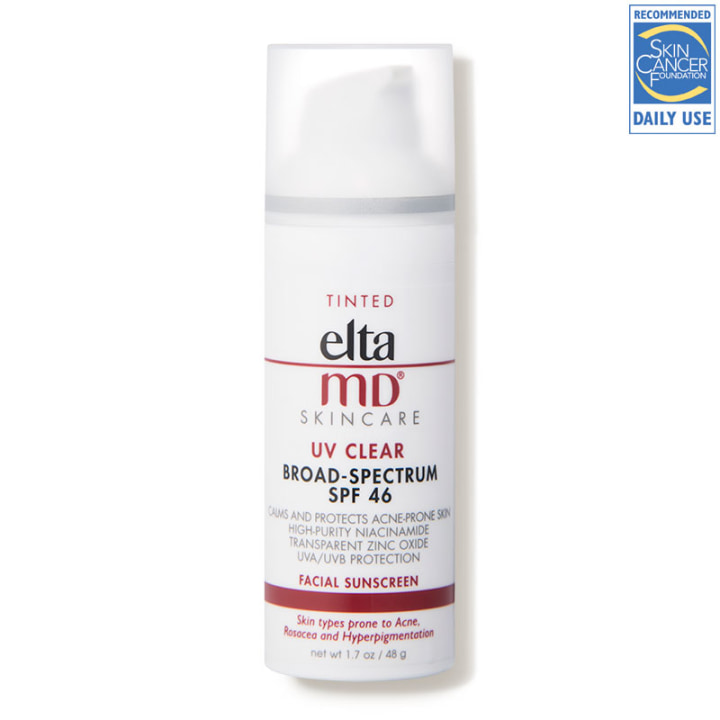
EltaMD Broad-Spectrum Sunscreen
Did you know that sunscreen is the number one anti-aging product? “I love that this sunscreen has a tinted, moisturizing base, so it can be used as a light foundation,” says Nichols. “In addition, it leaves no trace of chalky residue, which is something patients of my practices so often search for. Being a dermatologist, it is crucial to find products that work with all skin types and tones, and EltaMD truly delivers that with this product.”
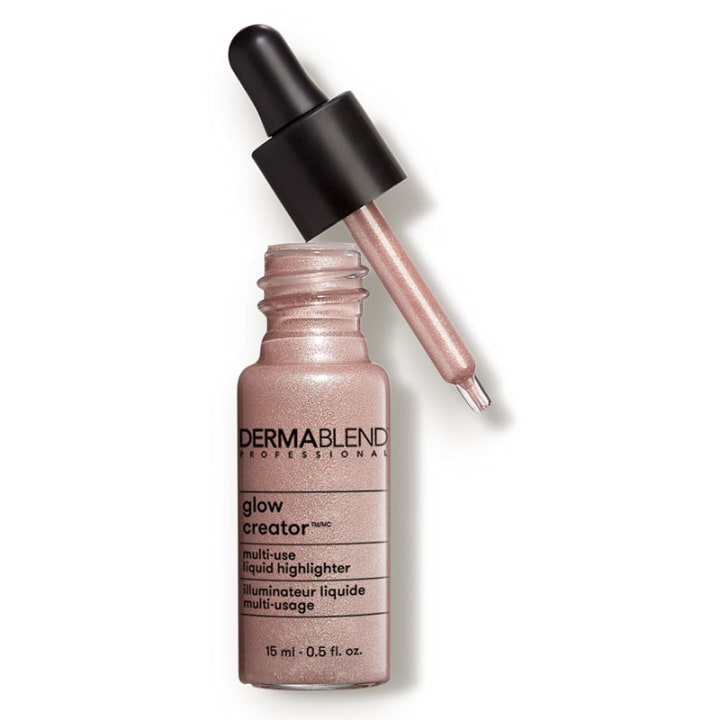
As a finishing touch, a great way to boost your glow is with highlighter. However, makeup so often clogs pores, leaving skin prone to breakouts. That is why Nichols go-to makeup is DermaBlend, a line of makeup created by both a dermatologist and a make-up artist. “Their highlighter, Glow Creator, is an oil-free formulation that is great for all skin types,” says Nichols. “My personal tip for an all-over glow is to blend one drop of the highlighter with your foundation—it provides a naturally dewy, radiant finish.”
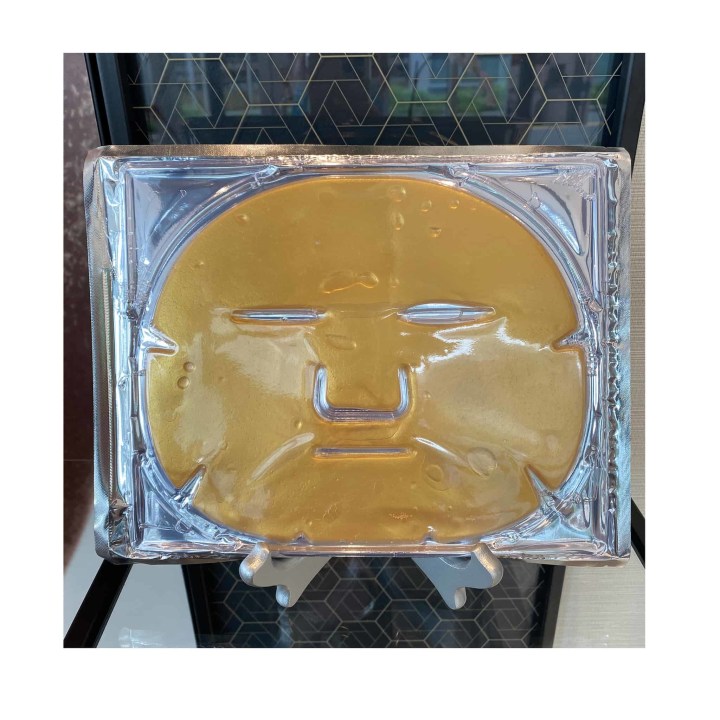
NicholsMD Caffeine Gold Masque
“Caffeine, as we all know, wakes up our minds, but it also aids in stimulating blood flow to the skin for a healthy glow, says Nicholas. “This is my go-to when my patients are looking to get event-ready.”
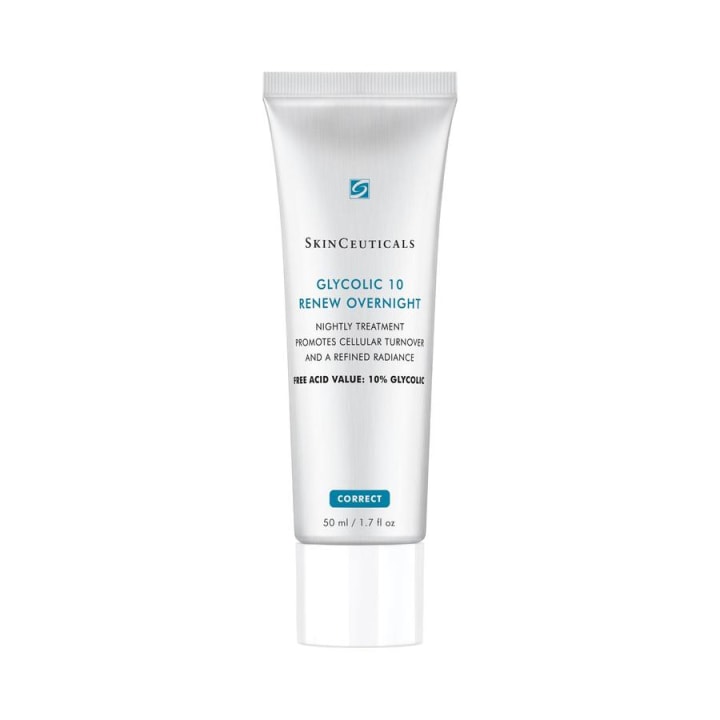
SKINCEUTICALS Glycolic 10 Renew
“If my patients are looking for brighter, radiant skin, the ultimate product to add into their regimen is this nightly treatment that’s packed with glycolic acid, an exfoliant that promotes cell turnover, and phytic acid to promote skin clarity and brightness,” says Nichols.
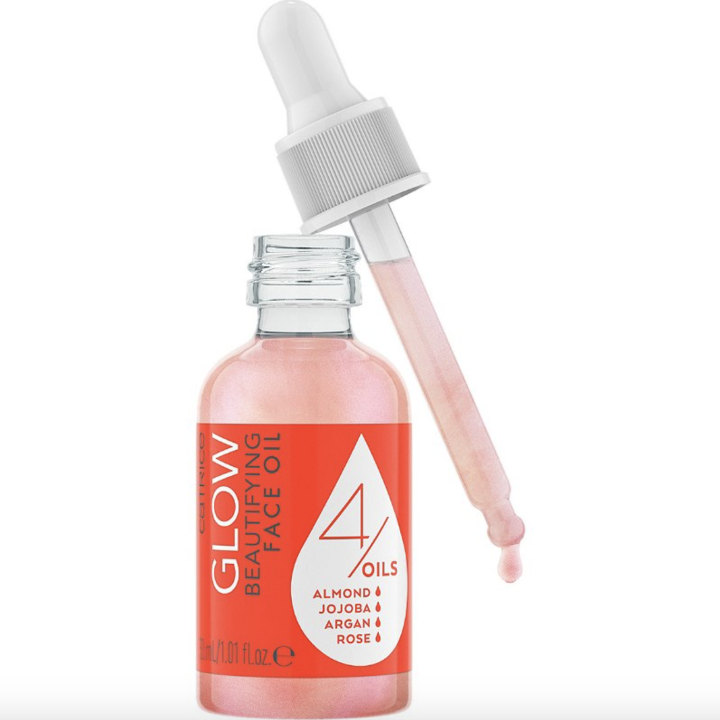
According to Robert Sesnek, celebrity makeup artist for Kendall Jenner, Hailey Bieber, Julianne Moore and others, this is a real favorite for adding a hydrating glow before applying foundation or other make up. A thing to keep in mind, he says, is to “not be afraid of over hydrating in winter or dryer months. You can always lightly blot excess moisturizer.”

It’s almost impossible to talk about moisturized skin without someone mentioning La Mer. It’s pricey, but for good reason. It’s a mashup of vitamins, oils, and minerals and works super hard at replenishing hydration. “I’ve been a fan of La Mer soft cream for years,” says Sesnek. “It really moisturizes especially in winter months and is great for drier skin types.”
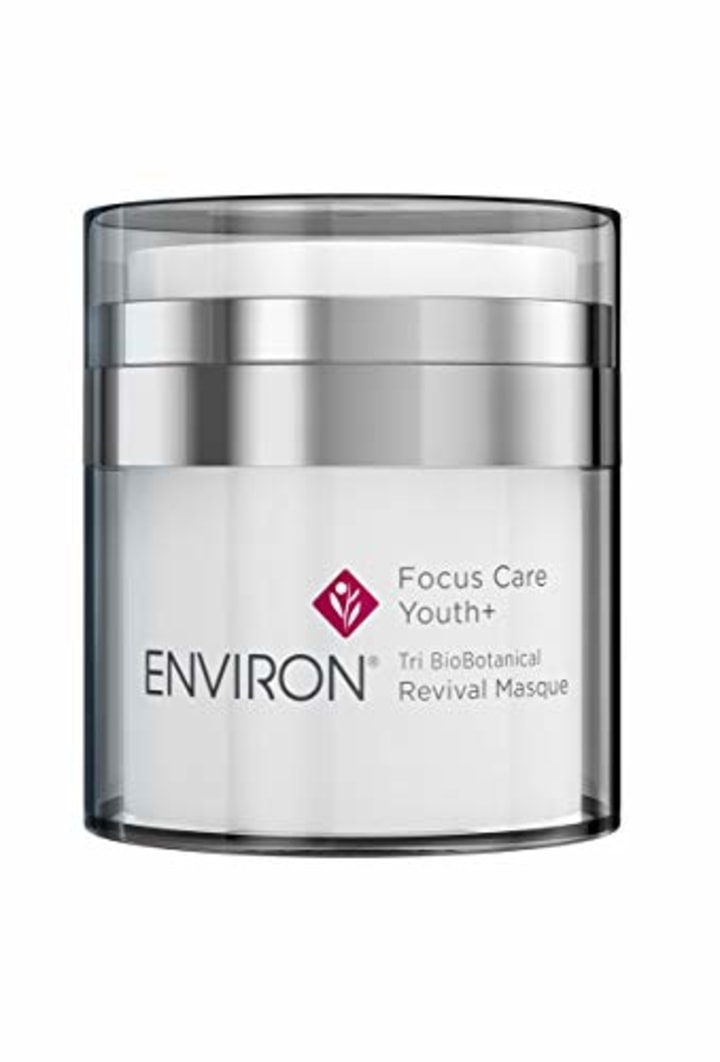
Also known as a facelift in a jar, this workhorse of a mask helps to improve the overall appearance of aging skin, uneven skin tone, and promotes natural skin hydration. It’s a favorite of Sarah Akram, celebrity Master Esthetician and owner of Sarah Akram Skincare because it reduces pigmentation, improves texture and gives skin the ultimate glow. “There are a few ways to apply this mask,” she says. “The first is to apply post-cleansing, leave on for 15-20 minutes, rinse, and add a serum or moisturizer. The second way to apply is as the last step, after cleansing and leaving on overnight. If I have plans for the evening, I apply the mask after I’ve cleansed my face and leave it on for 20 minutes as I’m getting ready to give my skin a glow before applying moisturizer and then makeup.”
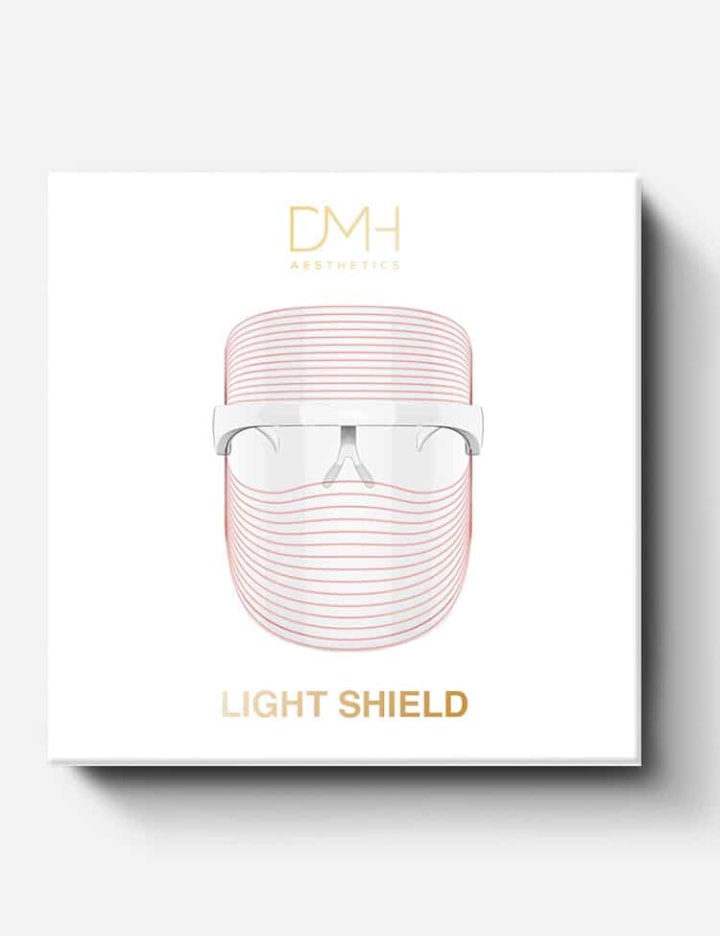
This celebrity-loved mask uses three different light settings (red, blue and amber LED therapies) to target a variety of skincare concerns — and all you have to do is sit. Nichols recommends using this amber light once a day. “The mask is ideal for helping reduce brown spots and other discoloration for an even and bright complexion,” she says. “I personally love this mask because it fits into the busy schedules we live; it sits perfectly on your face so you can multitask while working on your skincare.”


INTERVIEW WITH DR. KIM NICHOLS, MD, FAAD
These examples are intended to provide information and inspiration for your journey and are not a recommendation or endorsement.
Harvard-trained, board-certified dermatologist and cosmetic surgeon Kim Nichols, MD, FAAD, worked at her mentor’s practice for seven years on the Upper East side of Manhattan before opening her own practice in Greenwich, Connecticut in 2013. Since then, the staff has grown from 3 to 15, and Dr. Nichols recently opened a second location, in nearby Harbor Point. Here, she shares her experience on what she learned while creating her Medical Aesthetics practice.
Knowing the role you want to play in the industry can help you get there. “Not every healthcare professional or injector wants to own their own business and that’s okay,” Dr. Nichols says. But if your goal is to open your own practice, having the drive is key. “That entrepreneurial spirit, that hustle, is essential because that may help you create a sustainable practice and help you surround yourself with staff that also believe in that,” she says.
That entrepreneurial spirit, that hustle, is essential because that may help you create a sustainable practice and help you surround yourself with staff that also believe in that.
Dr. Nichols, through the lens of an experienced practice owner, suggests exploring different types of work environments, whether it’s a small, local practice or a franchise with multiple locations to find out where you want to practice. When she was looking to open a small boutique practice, she needed to know her local market. “People want to come to you obviously because of your credentials and your results, but they also want to know that you’re in tune with what they like,” she explains, and that can vary by region. She noted that larger franchise practice owners may need to be open to a wider variety of aesthetic tastes. The type of practice you want will also dictate how you structure your business plan. “It’s a question you need to keep asking yourself—what you want and where you see the practice going,” Dr. Nichols says.
Before you go into practice, whether your own or someone else’s, go to the state board and find out their requirements. For example, Dr. Nichols shared that aesthetician requirements in Connecticut differ from requirements in New York. She also shared that in her experience, it’s important to research what’s required for each role and to understand your state requirements for licensing. In Dr. Nichols’ experience, she noted that it may be helpful to learn exactly which procedures you can perform in-office, who can perform them, and the qualifications you and any potential staff will need.
A practice generally has a variety of roles that comprise a team. For example, when Dr. Nichols first opened with a staff of three—herself, a medical assistant, and a medical aesthetician, she was seeing patients, answering phones, and managing the business. Hiring an office operations manager freed her up to focus on other high level parts of the business and to focus on the care of patients. “Our operations manager brings it all together—without her, it wouldn’t work,” she says. Some aesthetics practices might also have patient care coordinators. In Dr. Nichols’ office, that role is filled by medical assistants and physician assistants, who use their knowledge about the procedures as well as the timelines involved to go over treatment plans with clients. And because it’s a small, localized operation, everyone in the office knows how to answer the phone. Dr. Nichols highlighted that it’s important to make sure everyone in the office has a baseline understanding of aesthetics and can appropriately respond to the patient or defer to someone who has an informed answer.
Dr. Nichols shares that for her, patient satisfaction is rooted in feedback. She advises to have strong patient communication by calling and emailing patients the day after procedures to check on how they’re doing. To understand patient satisfaction, she constantly surveys new patients about their experience with the practice, and considers the feedback carefully. “On the rare occasion that a patient gives us a 4 out of 5, my office will personally call to learn what we can do to make it a 5.” Dr. Nichols recommends researching books or literature on customer service when developing standards for practice customer service, “I highly recommend anyone looking to become a practice owner to make [patient satisfaction] their goal.”

Kim Nichols, MD, FAAD is a Harvard-trained, board-certified, celebrity dermatologist that treats for both medical and cosmetic skin care concerns.


Whether it’s the new phenomenon of maskne or a long-standing relationship with breakouts, acne is simply a part of many people’s skin care lives, and that’s okay. But if you do want to get rid of the (perfectly normal) blemishes you experience, you may be considering a lactic acid-based product. But does lactic acid help with acne? Bustle reached out to dermatologists to find out.
Top experts, including New York City-based dermatologist Dr. Hadley King, dermatologist Dr. Joshua Zeichner, director of cosmetic and clinical research in dermatology at Mount Sinai Hospital, and board-certified dermatologist and NicholsMD and NicholsMd of Fairfield Dr. Kim Nichols, for the intel. All three derms revealed everything you need to know about the buzzy chemical exfoliant and how it affects the skin — plus how it really stands up to zits.
Looking for a crash course on the skin care ingredient? The dermatologists shared their top tips on everything from what lactic acid does to your complexion, how it can treat breakouts, how to use it (and what not to use it with), and how to start incorporating it into your routine.
Read on for expert insight that’ll help you decide if lactic acid is right for your regimen.
We only include products that have been independently selected by Bustle’s editorial team. However, we may receive a portion of sales if you purchase a product through a link in this article.
Chances are you’ve seen lactic acid across beauty labels of cult-fave skin care products (like Sunday Riley’s Good Genes or The Ordinary’s Lactic Acid 5% + HA). That’s because it’s long been an exfoliating ingredient used in countless serums and moisturizers and recommended by derms and facialists alike.
Lactic acid is part of a skin care category called alpha-hydroxy acids (or AHAs), which “help to dissolve the bonds that hold dull, dead skin cells on the surface of the skin,” says King. Essentially, AHAs slough the buildup of debris — like makeup, dirt, and pollution that stick to your face throughout the day — to result in a smoother, brighter complexion.https://61426c1b62cd371999f062435a00b6d6.safeframe.googlesyndication.com/safeframe/1-0-38/html/container.html
Within the AHA category, though, lactic acid sets itself apart. According to King, lactic acid is a humectant which means it draws moisture into the skin — meaning it aids in hydration. Besides that, it tends to be more sensitive skin-friendly, says Zeichner, since lactic acid has a larger molecular structure than other AHAs which makes it easier for complexions to tolerate.
As for whether lactic acid works well for breakouts? The short answer is yes. But it’s important to know it’s not going to work the way traditional spot treatments do. Instead of drying out zits overnight, the AHA assists in combatting acne through exfoliation and hydration — so it isn’t for instant gratification even though it does the trick.
“When skin is dehydrated, it can contribute to acne proliferation and congestion,” Nichols tells Bustle. “Because lactic acid is a humectant, it attracts moisture to the skin. This, in turn, helps with acne by speeding up the rate which cells turnover and produce new, healthy skin.”
Another way it helps with acne is by unclogging pores. Zeichner explains that while lactic acid isn’t specifically approved for acne treatment, by removing dead skin cells and excess oil via gentle chemical exfoliation, it helps keep pores clear — which results in less breakouts.
If you’re interested in trying lactic acid, there are a few ways to incorporate it into your skin care routine. Both King and Zeichner suggest finding a toner or cleanser containing the ingredient. You can also try using a lactic acid-spiked mask as well as a serum — but no matter how you work it into your lineup, Nichols advises to go slow. Since it’s an active ingredient and can sometimes cause irritation, she recommends using it once every two days and working your way up in frequency if you feel that you need to do so.
“Any chemical exfoliant can potentially dry out and irritate the skin,” says King. If your skin begins to feel tight, dry, red, irritated, or flaky, she suggests taking a break from lactic acid until it’s healed. Then, try adding it back in less frequently, and, according to King, be sure to balance it out with good moisturizers.
It’s also important to be careful using the ingredient when you’re using other active products in your routine. “Be cautious in combining lactic acid products with others that contain potentially irritating ingredients, like other hydroxy acids or retinol, as using [them] together can lead to irritation,” Zeichner tells Bustle. “Layering hydroxy acid products is different from using a single product pre-formulated with multiple acids at lower concentrations that has been tested for tolerability.” So either spread out your actives, or reach for products formulated with several in one for your most skin-friendly solution.
And while you should already be doing this, don’t forget to add sunscreen. Zeichner notes that the AHA may make skin more sensitive to UV light (though you should be wearing SPF no matter what).
If you want to test lactic acid for yourself, try one of the dermatologist-recommended products below.


Every once in a while, a legit hack comes along on TikTok or Insta. Like using mascara to cover grays if you have dark hair, applying your concealer and blush under your foundation, or this genius hack for getting the perfect cat eye every single time.
All the above have a few things in common: they’re safe, they make something hard not-so-hard anymore, and they actually work. We don’t have to tell you that there are a lot of “hacks” out there that are the opposite! Tricky to pull off, borderline (if not straight-up) dangerous, and not really that effective at the end of the day.
We asked skincare pros to put the worst ones out there on blast. Here are the Insta and TikTok hacks they say you def should not try at home!
You might have seen that viral video on TikTok that recommended applying sunscreen only in certain areas to create a makeup-free sort of contouring effect. There’s even a hashtag for it (#SunscreenContouring). This one got a huge nope from several of the pros we talked to.
“This is dangerous, as UV rays and photodamage affects all areas of the face,” says Dr. Jeannette Graf, a board-certified dermatologist and assistant clinical professor of dermatology at Mount Sinai School of Medicine. “Skipping sunscreen on certain areas exposes the body to harsh rays, which can eventually lead to skin cancer and cause premature age spots and wrinkles.”
If you are looking for a contoured look, you’re better off going the traditional route. It doesn’t really take that long, it’s way easier, and loads safer! And don’t forget your SPF!
While lots of pantry ingredients do come in handy for a quick skincare DIY, a potato simply isn’t one of them when it comes to acne. People on TikTok have been using potatos to treat their acne, but our experts tell us it’s wasted effort.
“Some justify this as potato can contain small amounts of salicylic acid, but this raw potato application stunt to severe acne is just silly and ineffective,” says Dr. Melanie D. Palm, a board-certified dermatologist and medical director of Art of Skin MD in Solana Beach, Calif. “Why would someone apply a raw vegetable to the face when effective acne treatments exist over the counter, such as retinoids, benzoyl peroxide, and salicylic acid? These ingredients have proven effectiveness and are safety approved by the Food and Drug Administration (FDA).”
Potatoes are great and all and while they can be a useful DIY hack in a pinch, they’re really not very effective when it comes to treating acne! Potatoes already do so much for us, let’s give them a rest and use what works, instead!
Okay, we’re not gonna lie, we did try this one – but that’s our job, right? To try things so you don’t have to! The DL was very much that the finished look was definitely not cute and our lip certainly didn’t enjoy it either!
So if you love the idea of fuller lips, then we say stick to lip contour and steer clear of literally gluing your top lip to your upper lip. This doesn’t look good and it’s super unsafe. Lose-lose. This expert certainly thinks so anyway: “Eyelash glue contains cyanoacrylate which when applied onto the skin, can cause severe allergenic chemical reactions such as swelling and blistering,” says Dr. Palm. “If glue is ingested since it’s near the mouth, it can also cause sickness.”
Some people have even used legit superglue which is even worse. This one’s so not worth it.
No, we’re not kidding. Yes, we’re deeply horrified and concerned for humanity. Yes, we’re all about that #periodpower – talk about it, embrace it, normalize it – but we really don’t think it’s a good idea to use your period blood on your face, and our expert certainly agrees…
“This is just horrible. I’m guessing the premise is to mimic plasma rich platelet (PRP) procedures performed in a dermatologist’s office,” says Dr. Palm. “The effective portion of our whole blood that contains growth factors and proteins that encourage collagen growth is found in the watery serum portion of whole blood. Menstrual blood is essentially sloughed endometrial tissue, which… is not healthy tissue.”
What’s worse, Dr. Palm says it can even contain bacteria from the vaginal canal and, given the proximity to your bum, it may also be contaminated with E.coli. Big yikes.
Didn’t think it’d get worse than the period blood mask, did you? Sorry. At-home mole removing is apparently a trend, and it gets a huge nope from Dr. Graf.
This trend where people are using chemicals to attempt to scrape off their moles can lead to serious infections and scarring of the area,” she says. “If you are concerned about a mole, make a virtual or in-person consultation with your dermatologist to schedule a checkup or removal of the mole.”
The bottom line is that there is literally no safe way to remove a mole at home so don’t even think about it!
Exfoliating is a key step in the skincare handbook, but there are rules! DIYs in chemical-based exfoliation, especially targeted for your face, is a big no-go.
“While lemons do contain vitamin C, citric acid, and niacin – all found in medical-grade skincare – that does not mean using them on your skin is safe,” explains Dr. Kim Nichols, a board-certified dermatologist and founder of SkinCeuticals NicholsMd of Fairfield. “Lemons are highly acidic, which can cause serious and sometimes permanent damage to your face, especially when in the sun. Also, because each lemon is different, you truly never know what exactly you are putting on your skin, components-wise.”
If you really want to try to brighten your skin without spending, then we’ve always been fans of a little orange juice as a toner! But honestly, there are so many bomb formulations out there at every price point, and they’re much more effective.
Ultimately, DIYs can be great – we really love a coffee and sugar body scrub with a little coconut oil – but when it comes to your face, it’s better to stick to very gentle ingredients, like honey or yogurt. It’s also important to always patch test first and be very careful, especially if you have sensitive skin. Ever wondering if something is a good idea or not? Just message us!
Are there any recent beauty hacks you’ve discovered the world needs to know about? Share ‘em below.


“We see sulfates in so many skin care products because they create a lather that gives a stronger impression of cleaning power that most people love,” explains board-certified dermatologist Dr. Kim Nichols, M.D., F.A.A.D., with whom Elite Daily spoke for this article. “Sulfates aren’t necessarily bad, but there is a lot of controversy behind the ingredient. They can often dry out the skin and cause skin and eye irritation. Some people may also find that sulfates can lead to acne in facial products. Without sulfates in body wash, the formula will keep the skin pH balanced which, in turn, will lower the risk of those dreaded blemishes.”
Dr. Nichols (who recently launched her own sulfate-free body wash) says she generally recommends cleansers without sulfates to patients with eczema, psoriasis, or very sensitive skin, but she adds, “If you find yourself with skin or eye irritant issues, then it’s probably time to make the switch. [And] without sulfates or parabens in skin products, the benefit is that your skin will stay more protected and supple.”
Read on to shop five of the best body washes for dry skin, all free of both parabens and sulfates.
We only recommend products we love and that we think you will, too. We may receive a portion of sales from products purchased from this article, which was written by our Commerce team.
01 The Overall Best Sulfate-Free Body Wash $19

CeraVe’s Hydrating Body Wash is one of the best body washes you could buy, whether you have sensitive skin or not. It’s full of good-for-skin ingredients like smoothing urea, strengthening ceramides, and hydrating hyaluronic acid, and it’s free of fragrance, sulfates, parabens, and soap, so it’ll leave your skin feeling moisturized and soft rather than dry and stripped. It boasts the seal of acceptance from the National Eczema Association as well, meaning it’s safe for people with eczema or otherwise sensitive, reactive skin.
02 The Best Sulfate-Free Body Wash For Extremely Sensitive Skin $12

Vanicream’s super-simple cleansers, lotions, and shampoos tend to be the go-to choice for people with extreme skin sensitivities and allergies, since they’re free of basically every potentially irritating ingredient imaginable. This body wash is no different. It’s free of parabens, sulfates, dyes, soap, oil, fragrances, lanolin, botanical extracts, and even gluten, but it’ll still leave skin feeling cleansed and soft. You also get a lot of product (12 ounces) for a very fair price.
03 The Best Sulfate-Free Body Wash For Dry, Irritated Skin
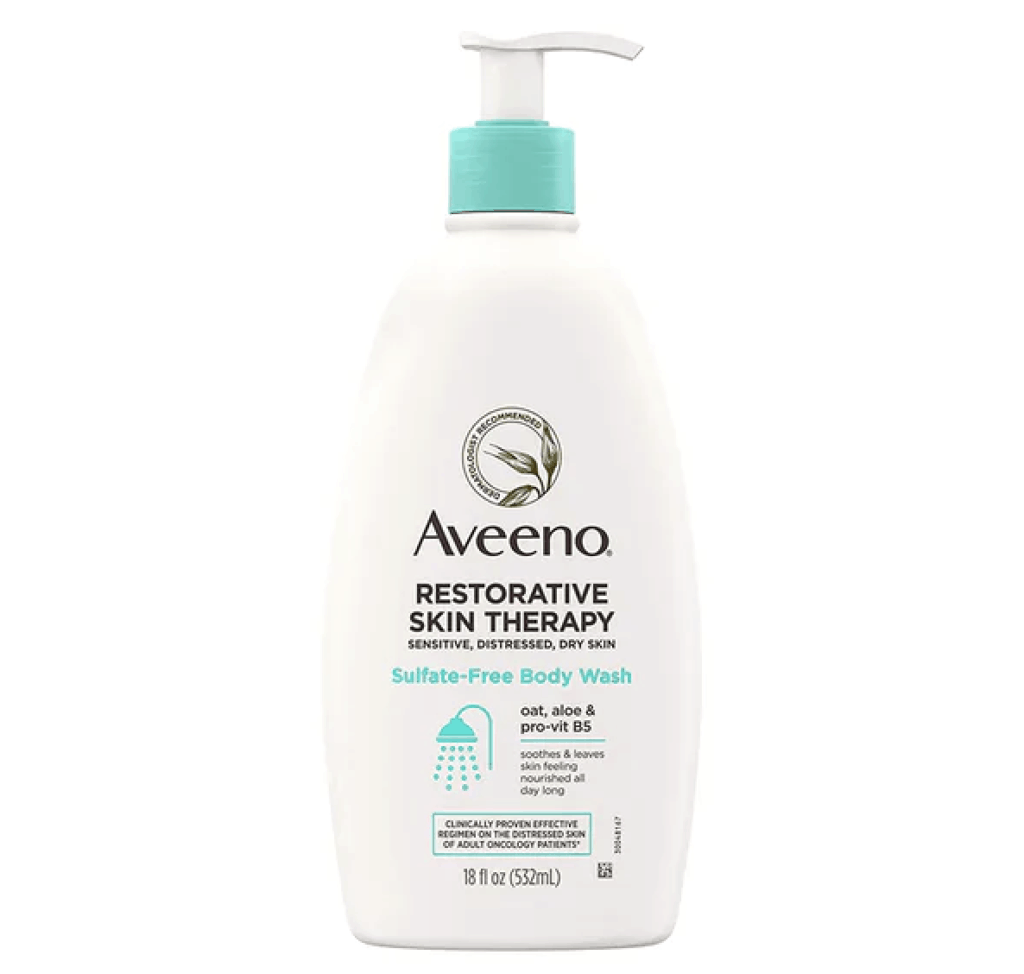
In Aveeno’s Restorative Skin Therapy Body Wash, oat and aloe provide lots of hydrating and skin-soothing benefits, making this a great choice for people with dry, itchy, or otherwise irritated skin. Made without parabens, sulfates, fragrance, or soap, it comes in a big, 18-ounce bottle that’ll last you ages.
04 The Best Scented Sulfate-Free Body Wash
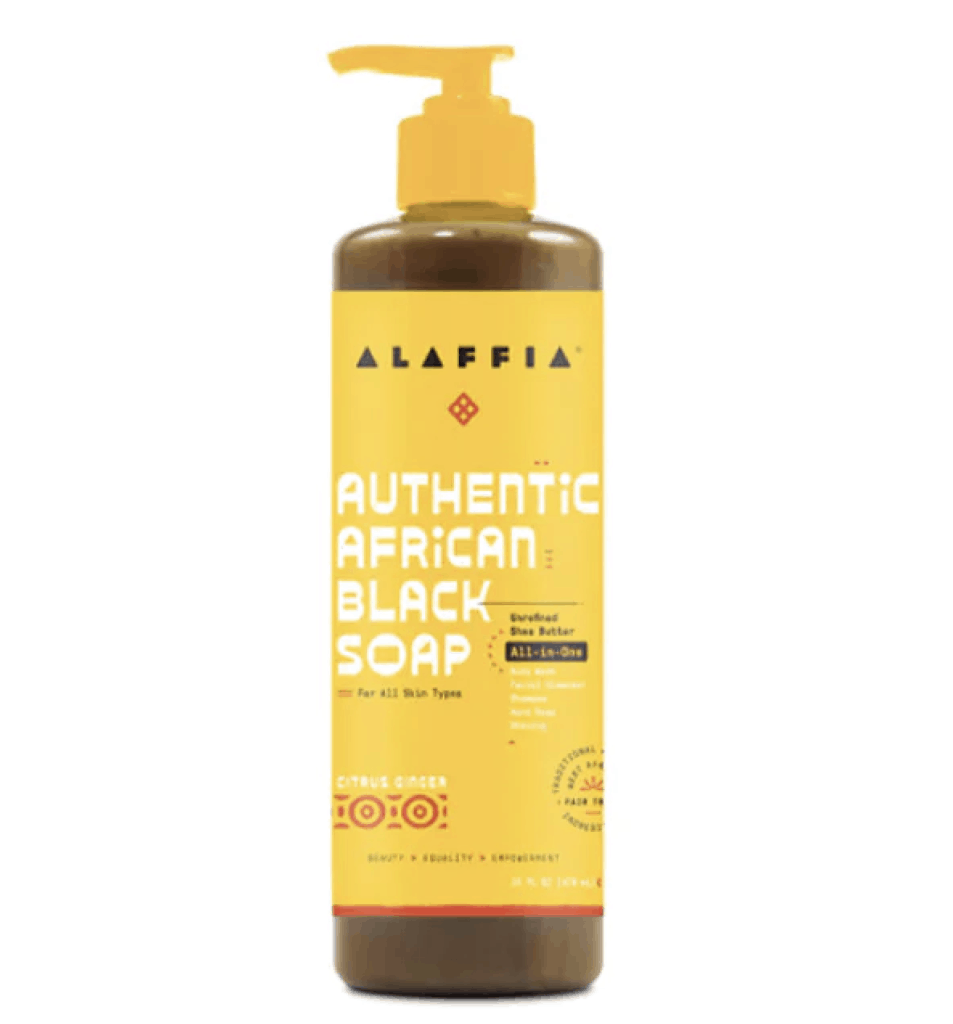
If you prefer scented products, check out Alaffia’s Authentic African Black Soap, which comes in 11 lovely scents, including vanilla almond, wild lavender, and eucalyptus tea tree. This is an impressively versatile soap that you can use on your face, body, hair, and hands, or even as shaving cream. It’s free of sulfates, parabens, phthalates, and synthetic fragrance, and it’s also cruelty-free.
05 The Best Sulfate-Free Body Oil
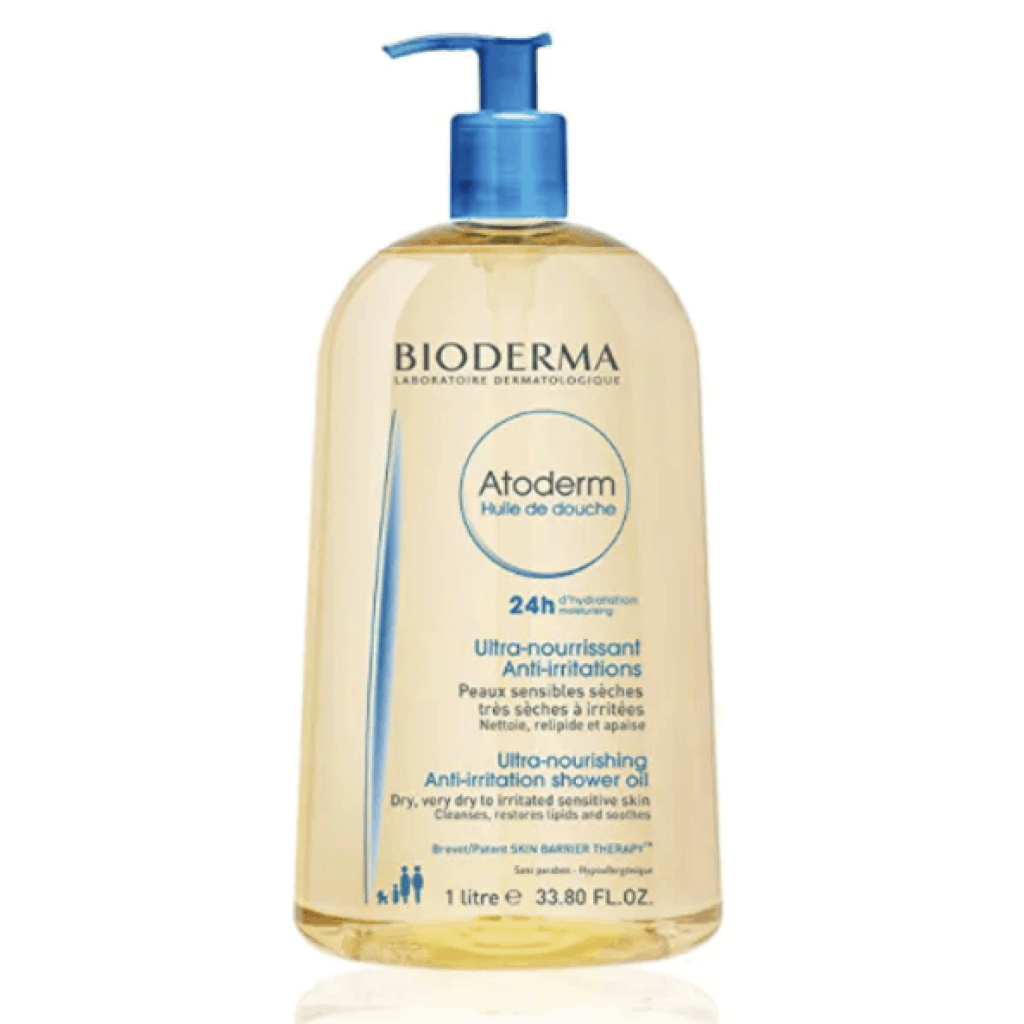
If you have very dry skin, you may want to consider switching to a shower oil. They’re even better at restoring moisture and leaving skin feeling silky soft, and like Alaffia’s African black soap, this one in particular can be used on your face and body. From Bioderma’s Atoderm line, which was formulated specifically for dry skin, this cleansing oil is made with vitamin B3, coconut and sunflower esters, glycerin, niacinamide, and other barrier-protecting ingredients. This comes in a massive, 33.8-ounce bottle — the biggest on this list — so you’ll likely be set for a good year.
Expert:
Dr. Kim Nichols, M.D., F.A.A.D., a board-certified dermatologist and founder of SkinCeuticals NicholsMd of Fairfield by NicholsMD.
The first doctor in her family, Dr. Nichols comes from a family of professionals with an entrepreneurial spirit she also embraces. Originally interested in plastic surgery, she was drawn to dermatology for the combination of “patient interaction, long-term relationships, and also ‘getting my hands in there’ as they say.”
Educated at Harvard University and NYU Medical center, Kim Nichols, MD completed her dermatology residency at King-Drew/Harbor-UCLA Medical Center in Los Angeles, where she served as Chief Resident. She practiced for several years in New York City before founding NicholsMD of Greenwich in Connecticut. The boutique practice is managed and staffed entirely by women.
I always wanted to run my own practice. As a woman owner, I knew I wanted the management to also be women, because I think that’s where we need the most support as women in business and in life—getting hands-on. I think it’s beneficial to build partnerships with other women who are doing business for themselves instead of women in corporate America where they don’t necessarily get to be at the very top.
It’s really worked out. Even entry level employees in our small organization still get experience in both the medical side and the financial side that they wouldn’t necessarily get at a bigger firm. And we’re growing! My aim is to make sure that wherever they go, that they will have this under their belts as a great experience with other women.
One of the challenges—and it’s not necessarily particular to women—is time management: Having big dreams but only having 24 hours to fulfill them or even less. I had to focus to carve out time for myself, my family, and my business. At certain points you want to push everything to one side. So there’s always going to be a challenge and a struggle, although it’s fun and exciting.
Dermatology presents unique opportunities, because it’s such a women-centered field in terms of beauty and competence—all these things that are not solely for women but historically have been. We have a unique ability to talk to our patients in a way that they understand, because we’re empathetic to it. We know exactly what they’re going through and may be feeling. That puts us in a unique spot as female dermatologists and business owners.
Branding has been vital since the beginning. Our brand centers on building confidence and clean beauty, not in the sense of organic, but in the sense of a natural look—what women really want. A lot of the brand is me personifying that. Keeping authentic throughout all our branding as we grow has been essential, even down to our colors and our logos. I want patients to see an article or a picture or social media post and know immediately that it’s NicholsMD. And I think that over these last eight years, we’ve established that.
In March, we opened Skin Lab. This is a new practice that is more centered toward accessible care for the millennial age group, but still with that high standard branding. So I think that, even in a different demographic, they would still know that these two practices are associated. That’s really been important throughout and will continue.
Number one would be my mentorship through Women’s Dermatologic Society during my residency. I had a month with Fran Cook-Bolden, MD in New York City, for whom I ended up working for almost seven years after residency. It worked out very well. She was such a great mentor, because she taught me about both sides, not just taking care of the patient and the procedures but even more importantly running your own business, the financial side of it. That was essential.
I’ve really tried to pass the baton, as it were. We make a point usually in non-COVID times to have at least one or two interns every couple of months. I have female residents come into the practice. I tell them with a lot of externships, it would be great if it works out like it did for me and leads to a job long-term, but it also is great if it doesn’t work out and you discover what you don’t want to do. Both things are important when you’re building your career. So I hope that I continue to do that for the young people coming through.
Personally would be, of course, my family, my children. I give them a model of how you can work and be a good mom at the same time, but not necessarily always be there for everything. I definitely think that is a big accomplishment of mine. I hope they would say the same. Professionally, I’d say is my mission to create this business and to grow it with mainly female managers. So far so good! We’ve been a success, and I hope to make it even bigger as we expand and grow.

Kim Nichols, MD is a board-certified dermatologist and cosmetic surgeon in Greenwich, CT where she owns her own practice, NicholsMD of Greenwich. She is a graduate of Harvard University as well as the NYU Medical School.
INTERVIEW WITH DR. KIM NICHOLS, MD, FAAD

These examples are intended to provide information and inspiration for your journey and are not a recommendation or endorsement.
Kim Nichols, MD, FAAD, is a Harvard-trained, board-certified dermatologist and cosmetic surgeon with her own practice in Connecticut. What she appreciates most about her 10-plus year career is how it allows her to marry her wisdom to her passion: “I love the fact that you’re using your medical knowledge, but also helping people achieve desired outcomes,” she says. Dr. Nichols trains other injectors in the art and ethics of administering aesthetic treatments, which means she knows firsthand what it takes to become a highly-skilled injector. Read some of Dr. Nichols’ top traits she believes experienced injectors should possess:
When you’re getting into the industry, it’s vital to learn from mentors and other injectors so you’re making sure safety is a priority, and anatomy is where you start.
“Anatomy is the most important thing,” Dr. Nichols says. “When you’re getting into the industry, it’s vital to learn from mentors and other injectors so you’re making sure safety is a priority, and anatomy is where you start.” For training, Dr. Nichols recommends starting with anatomy textbooks and credentialed journal articles.
For Dr. Nichols, building a bond with a patient begins with “credentialing yourself to the patient—making sure they know that you know what you’re doing,” she says. Next you’ll want to listen carefully to their needs and concerns, and lay out the plans you have for them. “I think that the biggest thing is making sure there’s transparency from the start,” says Dr. Nichols, “It tends to work out well in terms of achieving patients’ goals.”
Dr. Nichols urges new injectors to start slow and build their skills gradually. “I think a lot of early injectors try to jump into everything all at once and then they don’t really become great at anything,” she says. Instead, focus on mastering one skill at a time. “If it’s worth it for you to know how to administer neurotoxins, for example, get really good at that before you move on to other things,” she says.
Since there aren’t many cosmetic fellowships specific to medical aesthetics, early injectors should take the initiative to find mentors who will show them the ropes. “For me, it started with getting information from my mentors during externships,” explains Dr. Nichols, who feels lucky to have worked for seven years with a dermatologist who gave her full access to the aesthetics part of the practice. “That was huge because this dermatologist was doing a lot of studies and it opened the door for me,” she says. “It gave me a lot of opportunity to see and learn about aesthetics firsthand.”
It’s “grit and resourcefulness” that drives early injectors to seek out the training opportunities that helps set them up for success. That can mean following industry leaders on social media, approaching aesthetic professionals to be mentors, attending conferences, and learning as much as possible from pharmaceutical company webinars and trainings. “Some of the pharmaceutical reps that would come in were helpful in teaching more about aesthetics and leading me to resources,” Dr. Nichols says. She also learned a lot at conferences, such as those by the American Academy of Dermatology. “I would go through and circle all the aesthetics programs and then run around and kind of soak it all in,” she says.
Dr. Nichols is constantly reading journal articles and attending professional conferences to improve her techniques and learn new ones. “I have an open mind about what my colleagues are doing,” she says. “And that has to be continual or else your skills are going to get dated.” Dr. Nichols also meets with her staff biweekly to share topics and techniques they’ve seen from other experienced injectors on social media so Dr. Nichols can review and provide feedback based on her expertise as a board-certified dermatologist.
Dr. Nichols and her team devote a full hour to patient consultations, a significant investment of time that Dr. Nichols believes is important to establishing patient trust. The staffers explain the procedures they’re set to perform, how long treatment will last, the results they can expect, possible side effects, any measures patients should take in advance (such as stopping the usage of some skin care products which could adversely affect a treatment), any measures patients should take afterward (such as avoiding activities that could also adversely affect a treatment), and pricing, down to the sales tax. Perhaps most important is a recommended timeline that helps patients know how to plan to achieve their aesthetic goals. “It really is comprehensive, and again, it’s about taking the time,” she says.

Kim Nichols, MD, FAAD is a Harvard-trained, board-certified, celebrity dermatologist that treats for both medical and cosmetic skin care concerns.
Non-Surgical Face and Neck Lifts
Over time, I’ve found that many patients will avoid surgery at all costs. In today’s world, we all want results without the hassle and downtime of a surgical procedure. That is why in 2021, non-surgical face and neck lifts will become even more popular. At my practice, we will head into the new year with a focus on long-lasting, minimally-invasive thread lifts that correct sagging skin for immediate results, while also stimulating collagen for continued improvement in skin quality.
Healing Your Skin from The Inside Out
If 2020 has had one true pearl, it is that people have become increasingly focused on wellness and self-care. And I have always believed that beautiful skin is the result of a dedication to healthy living both inside and out. So in 2021, I predict my clients will take advantage of the many wellness treatments that we offer here, such as Far Infared treatments, Vitamin IVs, B12 and B-Complex shots, hair and collagen supplements.
Using Botox® in New Ways
As an Allergan ExpertInjectorTM, I have been administering Botox® for over fifteen years, and have trained other physicians in advanced techniques used for wrinkle reduction. However, what most people don’t know is that Botox® has an array of cosmetic uses besides treating wrinkles. For instance, when injected into the jaw muscles (the masseters) of the lower face, it decreases the size of the masseters, creating a sleek facial slimming effect. And in a procedure called Pore-minimizing Microtox, I inject Botox® superficially into facial skin to reduce pore size and oil production. I know that the coming year will only bring more innovative ways to use Botox® all over the body.
Signature Combination Treatments
Skin is dynamic. Therefore, in my consultations with patients, I tell them that my approach to anti-aging involves skin tightening and lifting, smoothing and volumizing, texture and tone, and at-home skincare. One treatment doesn’t do it all; so what I love to do is to devise customized plans that involve a combination of treatments (many done the same day!) which give my patients optimal results. Some of my most popular combination treatments include my Greenwich Non-Surgical Mommy Makeover, the Jawline Contouring treatment, and the Tech Neck procedure. And in the new year, I will offer a host of new bespoke treatments and skincare for my patients so stay tuned.
All About the Eyes
Although we hope to be done with masks forever in 2021, the one upside of masks has been that people learned to truly appreciate that their eyes are the most important feature of their face. And this is not going to change when masks go away. In the coming year there will continue to be a huge uptick in eye-related treatments. And one of my favorite combo treatments for eyes are our Signature Total Eye Rejuvenation treatments and brow lifts, which make my patients look refreshed, younger, like 2020 didn’t affect them at all (LOL)! Whatever the new year brings, my team and I are ready to help you gain the confidence to live your best lives every day. I look forward to seeing you at NicholsMD of Greenwich soon!
1. Does wearing makeup under your mask break you out even more than regular maskne?
Unfortunately, the addition of makeup under a mask can lead to additional congestion and clogged pores. This, in turn, can cause more consistent breakouts.
2. Should people only be wearing makeup on the top half of their face?
When possible, I tell my patients to go completely makeup-free. Otherwise, proper mask hygiene like washing everyday is imperative. If people choose to skip the makeup altogether, it is important that their daily antioxidants and sunscreens are still applied.
3. What can people do to prevent getting acne while wearing makeup under their mask?
There are several ways you can help prevent breakouts from frequent mask wearing. First, it is crucial that masks be washed frequently. In addition, using a fragrance-free laundry detergent is recommended, as fragrances can leave skin feeling irritated. Makeup, dirt, oils, and bacteria gather on your mask throughout the day, so it is best to wash after each use. Secondly, using medical-grade skincare products, like SkinCeuticals, and having a daily and nightly skincare regimen will help maintain healthy skin and protect it from all environmental factors. While washing your face with a gentle cleanser every morning and night will remove oils and bacteria that have gathered under you mask all day, carrying out a full regimen will help to keep skin clear, even, and glowing all the time. Further, keeping skin hydrated with moisturizer will help to act as a barrier between your face and the mask, which reduces friction and irritation.
4. Why does makeup break you out? Why does the mask break you out?
Breakouts occur for so many reasons, from genes and hormone changes, to clogged pores and other more serious skincare conditions. While it does not directly cause acne, makeup lends itself to breakouts because it clogs pores, trapping in whatever dirt, oils, and bacteria are on your face, fostering the growth of acne-causing bacteria. Masks trap your breath and sweat, causing a humid, sticky environment where acne-causing bacteria thrives. In addition, the constant pressure and friction from the mask rubbing against your skin can irritate it, causing bruising and discoloration in addition to acne. If these issues persist, it is best to see a board-certified dermatologist for possible solutions.
5. What would you recommend to fix this?
If wearing makeup is a must in your daily life, following simple steps, like frequently washing your mask and being sure to maintain a good skincare regimen will help correct and prevent mask-causing breakouts. In addition, choosing lightweight makeup that is good for your skin, like the Dermablend Flawless Creator, can help lessen these breakouts when they do happen.

Regular meetings can keep your practice team on track. Here’s what to include in every confab.
Consistent staff meetings are essential for defining and refining your practice’s culture. By having the team regularly come together to collaborate and evaluate the practice’s goals, staff meetings promote a sense of all-in attitude, deepening your employee’s commitment to the practice, the patients, and you.
Helping to define practice culture, establish standards, and educate staff are just a few key goals for staff meetings. Establish a consistent “template” and be sure to maintain a regular schedule for meetings in order to derive the most benefit.
After leading weekly staff meetings for more than five years, here is what we learned works to make our meetings productive, meaningful, and something our employees look forward to:
Welcome Notes from the Owner.Your staff will feel deeply valued when they hear directly from the owner and visionary every week.
We invite the entire staff to share articles and topics that they’ve come across in the medical and general literature. It empowers our staff to be up-to-date on the latest research and trends, so that they can best explain innovative technologies and new findings to our patients.
Welcome Notes or Reminders from the Manager. A 2019 study report shows that the average office worker receives 121 emails per day, so having regular meetings helps to ensure attention, compliance, and clarity regarding office operations and/or changes, because when your staff is informed, they are less likely to make mistakes.
Revenue Data. We review our goals via graphs and charts to see how we our doing in terms of our overall monthly revenue and retail goals. This financial transparency creates an “all-in, no-excuses” effort by the staff and sets them up clearly for earned staff incentives.
Patient Reviews. We review patient feedback that they have shared with staff; the surveys we send patients immediately after their appointments; and public reviews shared on Google or other online platforms. These reviews help us to continually monitor our client service so that we can deliver on what we promise. And we only expect the best, so even a 9/10-star review from a patient prompts us to closely examine the patient’s perspective.
Before & Afters. We believe before-and-after photos are the most important marketing tool in our field of aesthetic medicine. Therefore, at every staff meeting, we review the latest before-and-after photos from our practice and together discuss how to confidently highlight and market the results to our patients.
Staff Spotlight. Each week, we recognize a staff member for going above and beyond. Employee appreciation keeps them feeling valued and committed to your practice.
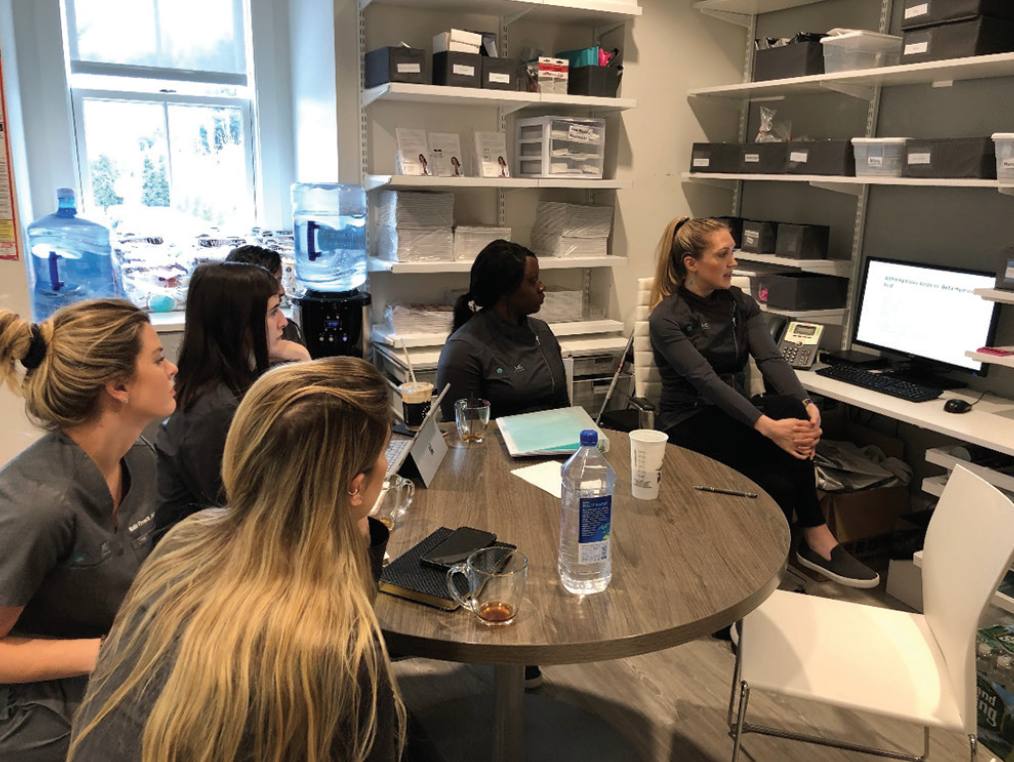
Nichols Dermatology Team Meeting, pre-COVID

Team meeting during COVID closure (same time and day only… we are on Zoom!)
Tip: Employees like to be recognized but they also like to give recognition. Have the staff member that was nominated for the previous week’s Staff Spotlight be responsible for nominating the following week’s Staff Spotlight.
At the end of every meeting, one staff member leads a 10-minute presentation on anything in their area of expertise within our office. This initiative was created to help support professional development of every staff member in every position. We have an organized rotation of all the staff members, so everyone knows they are expected to lead and when. We have had presentations on everything from how beauty trends differ across the world, how to use Stamps.com, and “Molluscum 101.” After their presentation, that staff member sends the other employees a short quiz on the information shared. The staff enjoys this initiative because for every five quizzes they complete, they earn one of our skincare products.
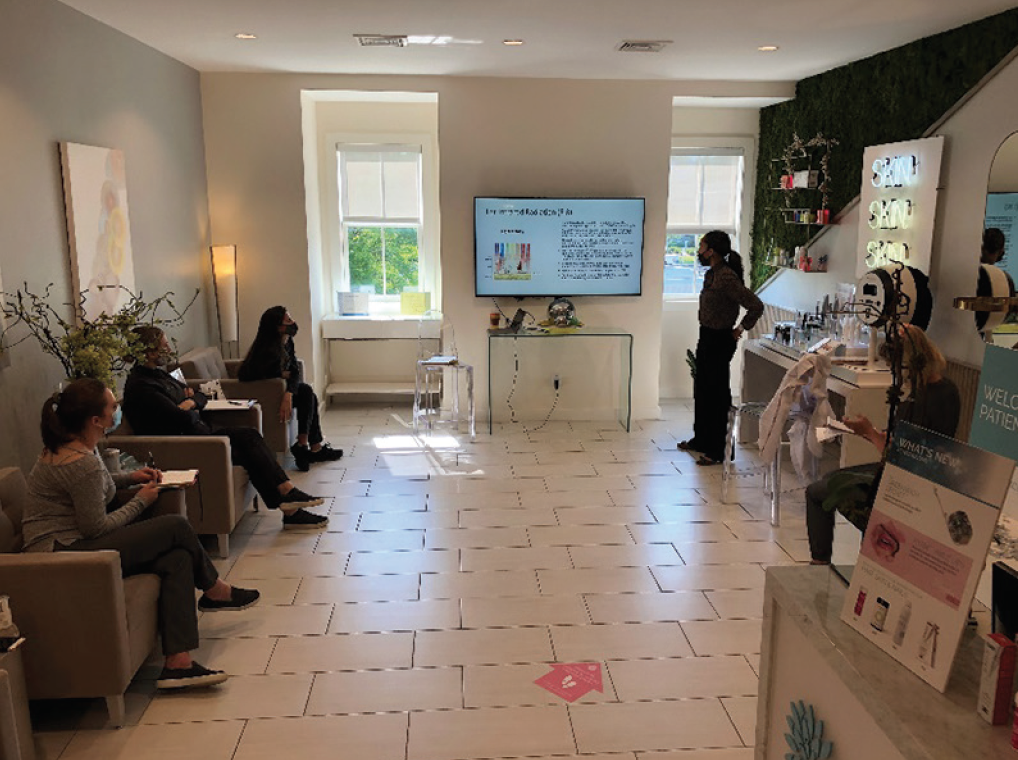
Post-COVID meetings: wearing masks, separated in our largest common space
Since staff meetings promote positive work culture, productivity, and teamwork, they should be regular. At our office, we have found Mondays to be the best day to host our weekly meeting because it sets the tone and expectations for the week ahead and dissipates any lag attitudes or weekend vibes. We stay to a strict 60-minute staff meeting and present the meeting in the form of a PowerPoint for visual cues and learners. Although the information changes weekly, the template is the same, which helps us to stay on topic and within the allotted time frame. So, by the time our first patient arrives, we are alert, refreshed, and motivated to see patients and make our goals for the week ahead!